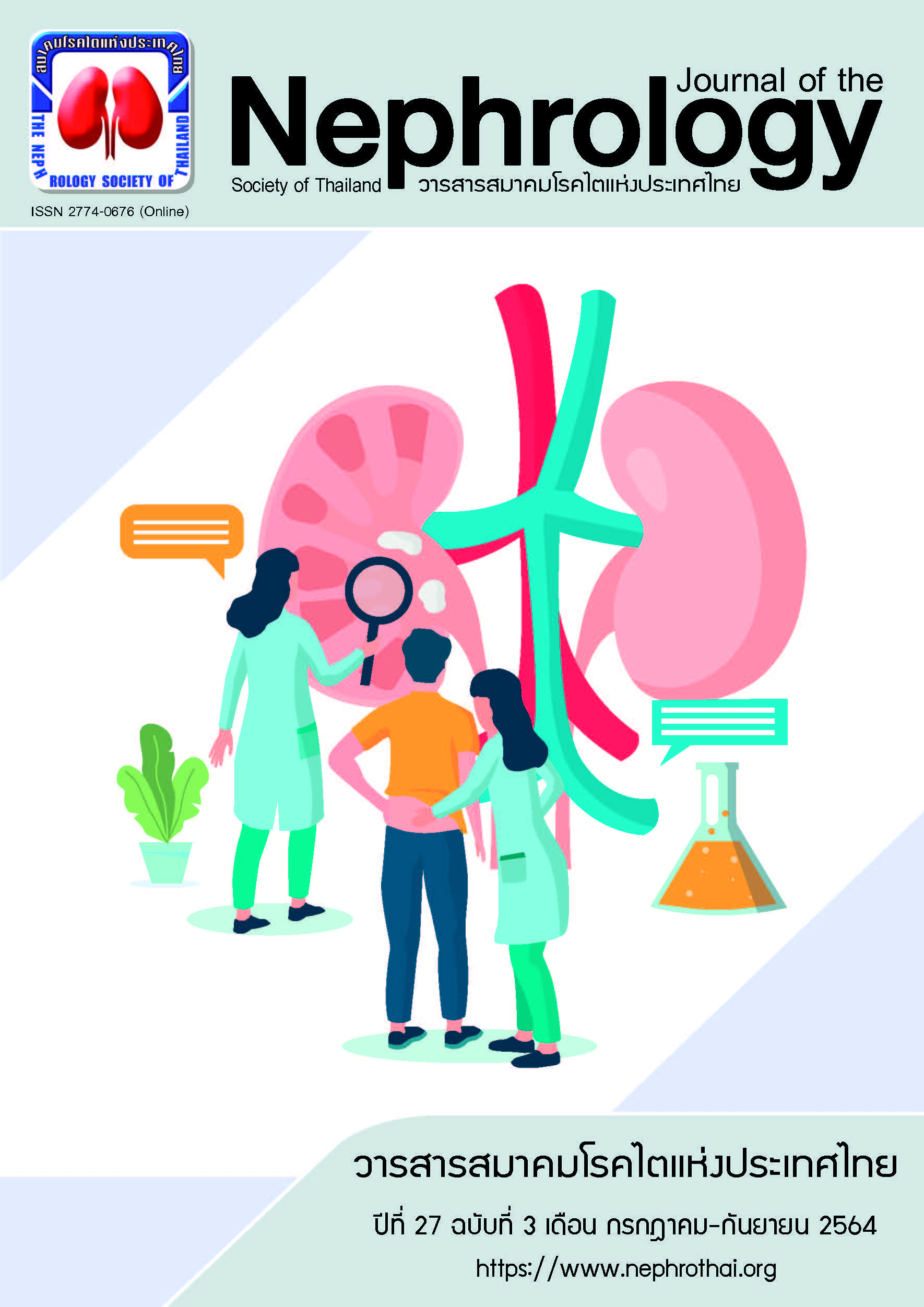Update on diagnosis and treatment of C3 glomerulopathy
Main Article Content
Abstract
Complement 3 glomerulopathy (C3G) is a rare renal disease which has been diagnosed and distinguished for the past 10 years. The disease is not only caused by genetic disorders but also acquired during a person’s life. The main mechanism is abnormal control of complement activation with deposition of complement 3 (C3) component in the kidneys leading to glomerular inflammation as well as glomerular damage. The clinical presentation of C3G varies from generalized edema, hypertension, microscopic hematuria, proteinuria, nephrotic syndrome, acute kidney injury to chronic kidney disease. The most common finding from light microscopy from kidney biopsy was membranoproliferative glomerulonephritis together with immunofluorescence has found complement 3 using dominant staining. Almost one half of patients with C3G present low serum C3 level. Currently, C3G cannot be completely cured due to a lack of randomized control trials; therefore, treating C3G refers to an observational study only. Prognosis of disease depends on the severity of renal pathology and cause of the disease; 70% of patients progress to end stage renal disease, on average 10 years while the relapse rate after kidney transplant can reach 50%.
Article Details

This work is licensed under a Creative Commons Attribution-NonCommercial-NoDerivatives 4.0 International License.
This article is published under CC BY-NC-ND 4.0 license, which allows for non-commercial reuse of the published paper as long as the published paper is fully attributed. Anyone can share (copy and redistribute) the material in any medium or format without having to ask permission from the author or the Nephrology Society of Thailand.
References
Barbour TD, Pickering MC, Cook HT. Recent insights into C3 glomerulopathy. Nephrol Dial Transplant. 2013;28(7):1685-93.
Thurman JM, Nester CM. All Things Complement. Clin J Am Soc Nephrol. 2016;11(10):1856-66.
Servais A, Noel LH, Roumenina LT, Le Quintrec M, Ngo S, Dragon-Durey MA, et al. Acquired and genetic complement abnormalities play a critical role in dense deposit disease and other C3 glomerulopathies. Kidney Int. 2012;82(4):454-64.
Medjeral-Thomas NR, O’Shaughnessy MM, O’Regan JA, Traynor C, Flanagan M, Wong L, et al. C3 glomerulopathy: clinicopathologic features and predictors of outcome. Clin J Am Soc Nephrol. 2014;9(1):46-53.
Bomback AS, Santoriello D, Avasare RS, Regunathan-Shenk R, Canetta PA, Ahn W, et al. C3 glomerulonephritis and dense deposit disease share a similar disease course in a large United States cohort of patients with C3 glomerulopathy. Kidney Int. 2018;93(4):977-85.
Zhang Y, Nester CM, Martin B, Skjoedt MO, Meyer NC, Shao D, et al. Defining the complement biomarker profile of C3 glomerulopathy. Clin J Am Soc Nephrol. 2014;9(11):1876-82.
Barbour TD, Ruseva MM, Pickering MC. Update on C3 glomerulopathy. Nephrology Dialysis Transplantation. 2014;31(5):717-25.
De Vriese AS, Sethi S, Van Praet J, Nath KA, Fervenza FC. Kidney Disease Caused by Dysregulation of the Complement Alternative Pathway: An Etiologic Approach. J Am Soc Nephrol. 2015;26(12):2917-29.
Marinozzi MC, Chauvet S, Le Quintrec M, Mignotet M, Petitprez F, Legendre C, et al. C5 nephritic factors drive the biological phenotype of C3 glomerulopathies. Kidney Int. 2017;92(5):1232-41.
Smith RJH, Appel GB, Blom AM, Cook HT, D’Agati VD, Fakhouri F, et al. C3 glomerulopathy - understanding a rare complement-driven renal disease. Nat Rev Nephrol. 2019;15(3):129-43.
Servais A, Fremeaux-Bacchi V, Lequintrec M, Salomon R, Blouin J, Knebelmann B, et al. Primary glomerulonephritis with isolated C3 deposits: a new entity which shares common genetic risk factors with haemolytic uraemic syndrome. J Med Genet. 2007;44(3):193-9.
Iatropoulos P, Daina E, Curreri M, Piras R, Valoti E, Mele C, et al. Cluster Analysis Identifies Distinct Pathogenetic Patterns in C3 Glomerulopathies/Immune Complex-Mediated Membranoproliferative GN. J Am Soc Nephrol. 2018;29(1):283-94.
Caliskan Y, Torun ES, Tiryaki TO, Oruc A, Ozluk Y, Akgul SU, et al. Immunosuppressive Treatment in C3 Glomerulopathy: Is it Really Effective? Am J Nephrol. 2017;46(2):96-107.
Mansour AM, Lima LH, Arevalo JF, Amaro MH, Lozano V, Ghannam AB, et al. Retinal findings in membranoproliferative glomerulonephritis. Am J Ophthalmol Case Rep. 2017;7:83-90.
Corvillo F, Lopez-Trascasa M. Acquired partial lipodystrophy and C3 glomerulopathy: Dysregulation of the complement system as a common pathogenic mechanism. Nefrologia. 2018;38(3):258-66.
Goodship TH, Cook HT, Fakhouri F, Fervenza FC, Fremeaux-Bacchi V, Kavanagh D, et al. Atypical hemolytic uremic syndrome and C3 glomerulopathy: conclusions from a “Kidney Disease: Improving Global Outcomes” (KDIGO) Controversies Conference. Kidney Int. 2017;91(3):539-51.
Hauer JJ, Shao D, Zhang Y, Nester CM, Smith RJH. Factor B and C4b2a Autoantibodies in C3 Glomerulopathy. Front Immunol. 2019;10:668.
Ravindran A, Fervenza FC, Smith RJH, Sethi S. C3 glomerulopathy associated with monoclonal Ig is a distinct subtype. Kidney Int. 2018;94(1):178-86.
Le Quintrec M, Lapeyraque AL, Lionet A, Sellier-Leclerc AL, Delmas Y, Baudouin V, et al. Patterns of Clinical Response to Eculizumab in Patients With C3 Glomerulopathy. Am J Kidney Dis. 2018;72(1):84-92.
Rabasco C, Cavero T, Roman E, Rojas-Rivera J, Olea T, Espinosa M, et al. Effectiveness of mycophenolate mofetil in C3 glomerulonephritis. Kidney Int. 2015;88(5):1153-60.
Catikkas M, Demir E, Ozluk Y, Caliskan Y, Badur RM, Turkmen A. Case report: C3 glomerulopathy advancing atypical hemolytic uremic syndrome. Nefrologia. 2018;38(4):450-2.
Kurtz KA, Schlueter AJ. Management of membranoproliferative glomerulonephritis type II with plasmapheresis. J Clin Apher. 2002;17(3):135-7.
Zand L, Lorenz EC, Cosio FG, Fervenza FC, Nasr SH, Gandhi MJ, et al. Clinical findings, pathology, and outcomes of C3GN after kidney transplantation. J Am Soc Nephrol. 2014;25(5):1110-7.
Bomback AS, Smith RJ, Barile GR, Zhang Y, Heher EC, Herlitz L, et al. Eculizumab for dense deposit disease and C3 glomerulonephritis. Clin J Am Soc Nephrol. 2012;7(5):748-56.


